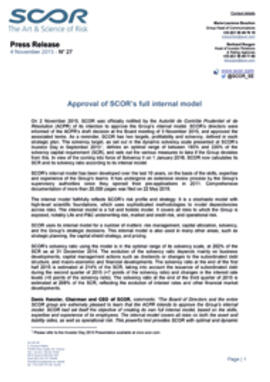Body
On 2 November 2015, SCOR was officially notified by the Autorité de Contrôle Prudentiel et de Résolution (ACPR) of its intention to approve the Group’s internal model. SCOR’s directors were informed of the ACPR’s draft decision at the Board meeting of 3 November 2015, and approved the associated terms. As a reminder, SCOR has two targets, profitability and solvency, defined in each strategic plan. The solvency target, as set out in the dynamic solvency scale presented at SCOR’s Investor Day in September 20131, defines an optimal range of between 185% and 220% of the solvency capital requirement (SCR), and sets out the various measures to take if the Group deviates from this. In view of the coming into force of Solvency II on 1 January 2016, SCOR now calculates its SCR and its solvency ratio according to its internal model.
SCOR’s internal model has been developed over the last 10 years, on the basis of the skills, expertise and experience of the Group’s teams. It has undergone an extensive review process by the Group’s supervisory authorities since they opened their pre-applications in 2011. Comprehensive documentation of more than 20,000 pages was filed on 22 May 2015.
The internal model faithfully reflects SCOR’s risk profile and strategy. It is a stochastic model with high-level scientific foundations, which uses sophisticated methodologies to model dependencies across risks. The internal model is a full and holistic model. It covers all risks to which the Group is exposed, notably Life and P&C underwriting risk, market and credit risk, and operational risk.
SCOR uses its internal model for a number of matters: risk management, capital allocation, solvency, and the Group’s strategic decisions. This internal model is also used in many other areas, such as strategic planning, the capital shield strategy, and pricing.
SCOR’s solvency ratio using the model is in the optimal range of its solvency scale, at 202% of the SCR as at 31 December 2014. The evolution of the solvency ratio depends mainly on business developments, capital management actions such as dividends or changes to the subordinated debt structure, and macro-economic and financial developments. The solvency ratio at the end of the first half 2015 is estimated at 214% of the SCR, taking into account the issuance of subordinated debt during the second quarter of 2015 (+7 points of the solvency ratio) and changes in the interest rate levels (+5 points of the solvency ratio). The solvency ratio at the end of the third quarter of 2015 is estimated at 208% of the SCR, reflecting the evolution of interest rates and other financial market developments.
Denis Kessler, Chairman and CEO of SCOR, comments: “The Board of Directors and the entire SCOR group are extremely pleased to learn that the ACPR intends to approve the Group’s internal model. SCOR had set itself the objective of creating its own full internal model, based on the skills, expertise and experience of its employees. The internal model covers all risks on both the asset and liability sides, as well as operational risk. This powerful tool provides SCOR with optimal and dynamic management of its capital, which faithfully reflects its risk profile. The current solvency level at the end of the third quarter 2015 is in the optimal solvency range”.
1 Please refer to the Investor Day 2013 Presentation available at www.scor.com
1 Please refer to the Investor Day 2013 Presentation available at www.scor.com
